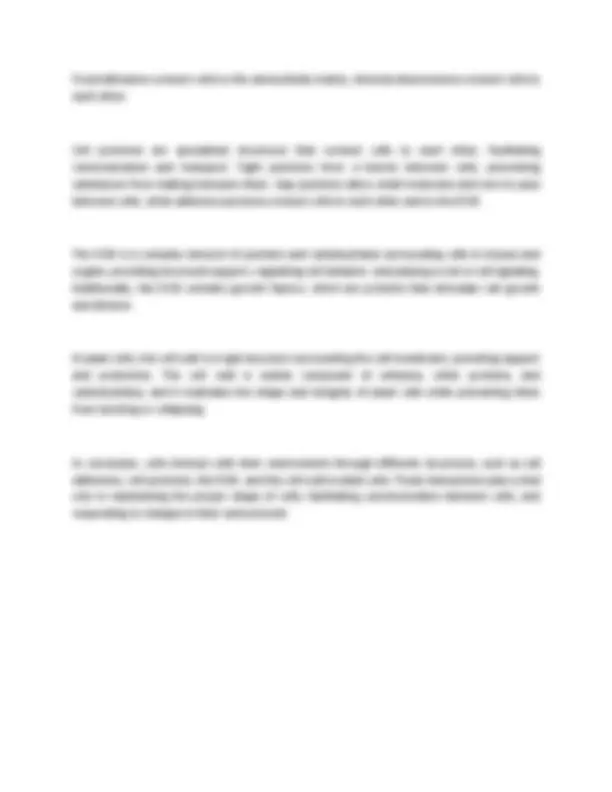




Study with the several resources on Docsity

Earn points by helping other students or get them with a premium plan


Prepare for your exams
Study with the several resources on Docsity

Earn points to download
Earn points by helping other students or get them with a premium plan
Community
Ask the community for help and clear up your study doubts
Discover the best universities in your country according to Docsity users
Free resources
Download our free guides on studying techniques, anxiety management strategies, and thesis advice from Docsity tutors
Introduction to cell biology: Milestones in cell biology, Cell theory, Properties of cell, Classification of cell, Structural organization of prokaryotic and eukaryotic cell. Comparison of microbial, plant and animal cells. Origin and evolution of cells. Theory of microscopy and types of microscope II. Structure and function of plasma membrane. Transport across membranes: active, passive, diffusion and osmosis. Interaction between cell and its environment- cell adhesions , cell junction, extracellular matrix and cell wall.
Typology: Study notes
1 / 4

This page cannot be seen from the preview
Don't miss anything!



The plasma membrane, or cell membrane, is a flexible, thin barrier that surrounds the cytoplasm of a cell and separates it from its surroundings. It is made up of a lipid bilayer, consisting of two layers of phospholipid molecules, with hydrophilic heads and hydrophobic tails. The primary function of the plasma membrane is to control the movement of substances in and out of the cell. Due to the hydrophobic nature of the lipid bilayer, most molecules, including ions and polar molecules, cannot pass through the membrane without the assistance of specific transport proteins. However, the plasma membrane contains various proteins that permit particular molecules to pass through. Some proteins function as channels, forming pores that allow selective molecules or ions to pass through, while others act as carriers, binding to specific molecules and transporting them across the membrane. Furthermore, the plasma membrane is involved in cell signaling and communication. It contains receptor proteins that bind to signaling molecules like hormones and neurotransmitters, triggering a response inside the cell. The plasma membrane is also responsible for cell adhesion, which is the process by which cells attach to one another and to the extracellular matrix. Integrins, a type of protein present in the plasma membrane, link to extracellular matrix proteins, anchoring the cell in place. In summary, the plasma membrane is a critical component of the cell, controlling its interaction with the environment, and playing a significant role in preserving homeostasis, which is vital for the cell's survival and function.
The movement of molecules and ions across the cell membrane is known as transport across membranes. This process can occur through a variety of mechanisms, including passive and active transport, as well as diffusion and osmosis.
Passive transport, which does not require energy input, can occur in two ways. Diffusion is the movement of molecules from a region of high concentration to a region of low concentration, resulting in even distribution over time. Non-polar molecules, such as oxygen and carbon dioxide, primarily use diffusion to cross the cell membrane. Osmosis is the movement of water molecules from an area of high water concentration to an area of low water concentration, regulated by specialized proteins called aquaporins. Osmosis plays a significant role in maintaining cellular water balance. Active transport, on the other hand, requires energy input. Primary active transport occurs when a protein pump uses ATP to transport molecules or ions against their concentration gradient. An example is the sodium-potassium pump, which moves sodium ions out of the cell and potassium ions into the cell. Secondary active transport occurs when a protein pump uses the energy from the movement of one molecule or ion down its concentration gradient to transport another molecule or ion against its gradient. The sodium-glucose co-transporter is an example of this, using the energy from the movement of sodium ions down their gradient to transport glucose against its gradient. Overall, transport across membranes is essential for maintaining proper molecule and ion balance inside and outside of cells, allowing for proper cellular function. Passive and active transport, diffusion, and osmosis are crucial mechanisms for this balance to be maintained.
Cells interact with their environment in various ways, which involve different structures such as cell adhesions, cell junctions, the extracellular matrix (ECM), and the cell wall (in plant cells). Cell adhesions are proteins present on the cell membrane, allowing cells to attach to each other and to surfaces, which is necessary for maintaining tissue and organ structure and cell signaling.